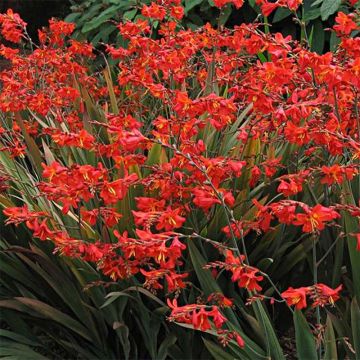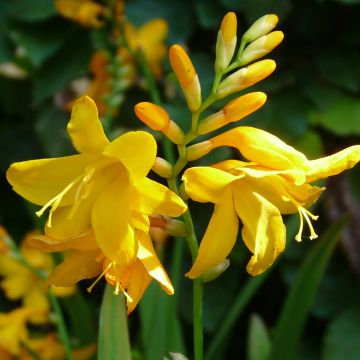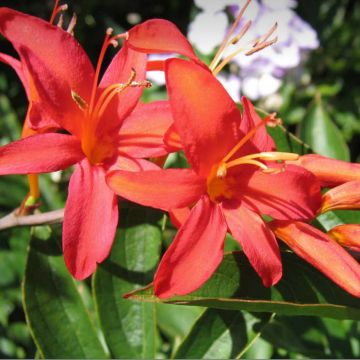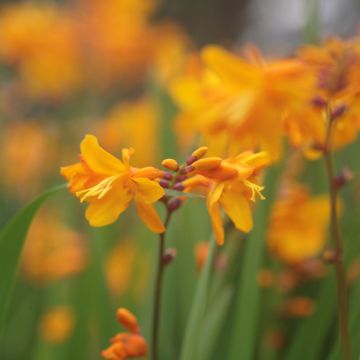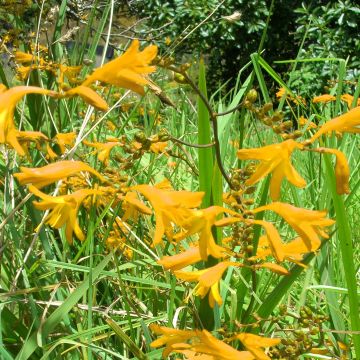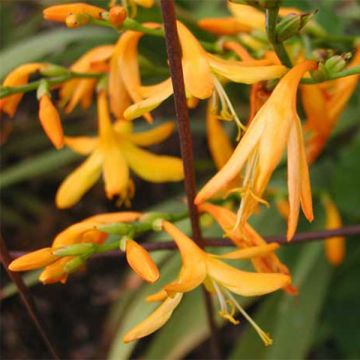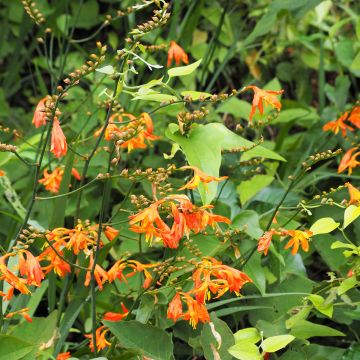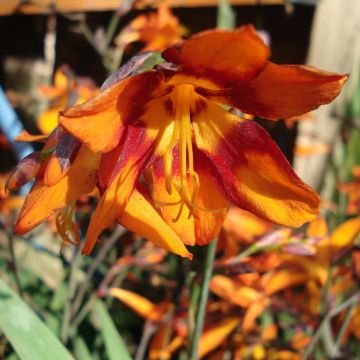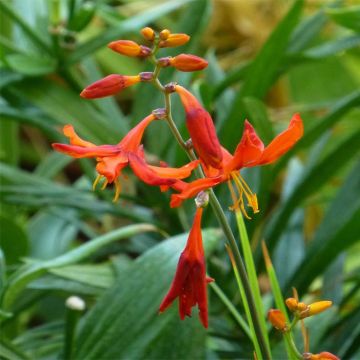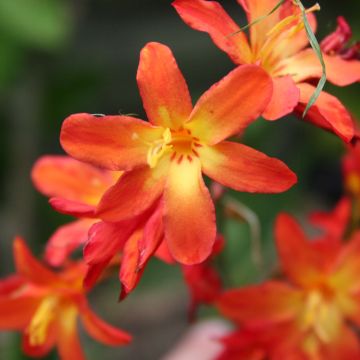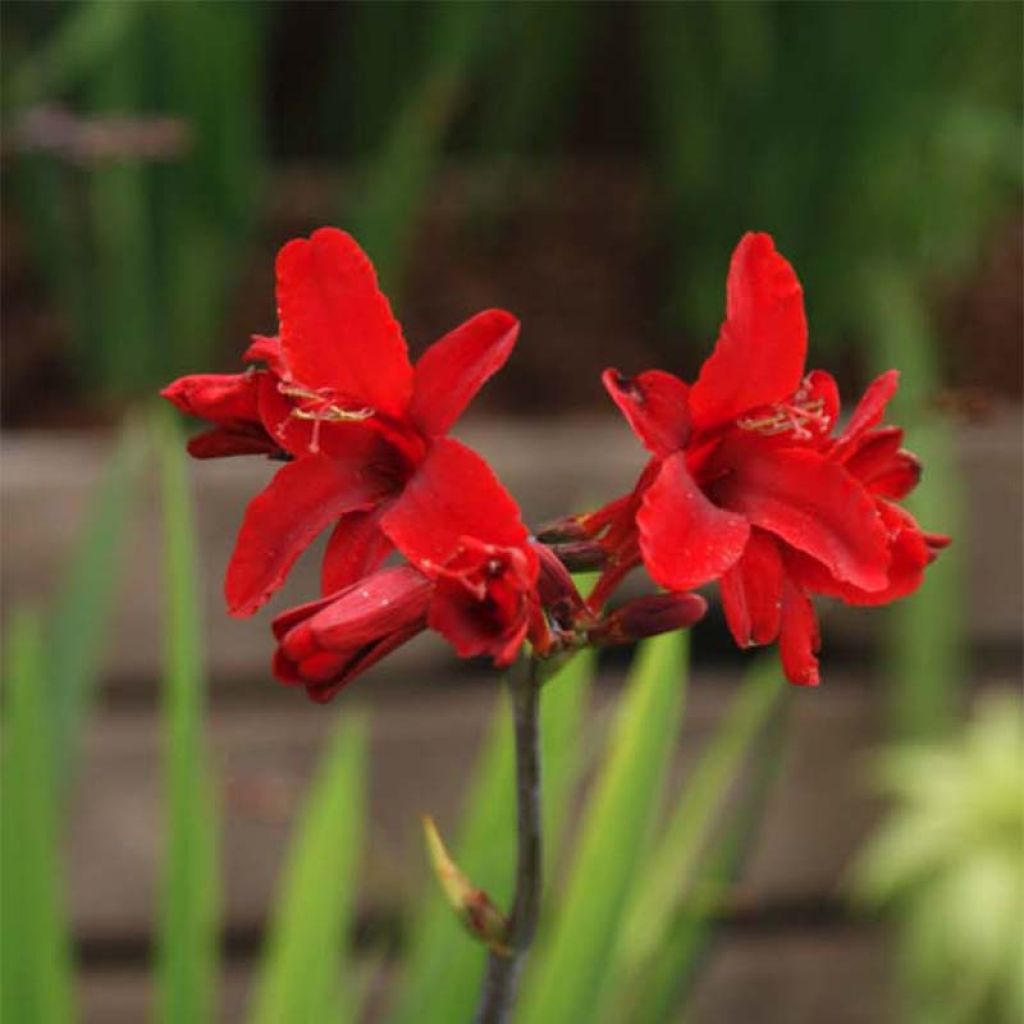

Crocosmia Hellfire® - Montbretia hybride rouge vif.
Crocosmia Hellfire - Montbretia
Crocosmia Hellfire
Montbretia
planted last September... here are my vine-plants starting their flowering BIG DISAPPOINTMENT because all the plants received are clearly not "Hellfire" crocosmias... Some would rather be classically "Lucifer" ones, much more orangish... really a shame...
Graziella, 04/07/2022
This item cannot be shipped to the selected country
Delivery charge from €5.90
More information
Schedule delivery date,
and select date in basket
This plant carries a 12 months recovery warranty
More information
We guarantee the quality of our plants for a full growing cycle, and will replace at our expense any plant that fails to recover under normal climatic and planting conditions.
From €5.90 for pickup delivery and €6.90 for home delivery
Express home delivery from €8.90.
Does this plant fit my garden?
Set up your Plantfit profile →
Description
The Crocosmia hybrid 'Hellfire' is one of the best varieties of red-flowered Montbretia obtained in recent years. The plant is vigorous and floriferous, and its black flower stalks support bouquets of very large, fully open, velvety flowers of a superb crimson red without any trace of orange. They are larger and darker than those of Crocosmia Lucifer. A little later than other hybrid crocosmias, the flowering lasts until September above abundant foliage reminiscent of iris leaves. This incredibly generous plant can quickly grow like a gladiolus in the sun and moist soil. Its sumptuous flowers stand out in flower beds, containers, or bouquets.
Crocosmia is a herbaceous perennial plant with corms originating from South Africa, belonging to the Iridaceae family. It shows many similarities with the gladiolus and is grown the same way in cooler climates. In nature, Crocosmia develops in the sun, in moist soils in summer, and in drier soils in winter.
The 'Hellfire' variety, recently obtained in England, offers something new. The plant, vigorous and of beautiful stature, forms in spring a shrub of basal leaves, flexible, 60 cm (24in) tall, and produces strong, slightly arched stems, very dark in colour, 90 cm (35in) to 1 m (3ft) tall. Each branch carries a branching spike, horizontal, with numerous buds that open into large flowers about 6 cm (2in) in diameter in July-August. The flowers are widely flared in this variety, composed of 6 red petals fused into a tube at the base. The dark green leaves are sword-shaped. They are crumpled, strongly veined, and spread out in a dense fan or cluster from the base of the plant. The reserve organ of Crocosmia is a corm, an underground pseudo-bulb that looks like a bulb but is formed from a swollen stem surrounded by scales.
Half-bulb, half-shrub, and Montbretia symbolise the splendour of summer better than any other plant with their abundant and cheerful flowering. Easy to grow, vigorous, and not demanding, they are planted in the sun, in groups of 10 corms, in fertile and moist soil. Their bright colours, yellow, orange, or red, form very cheerful spots of colour in gardens. They are splendid with annuals (Cosmos, love-in-a-mist, poppies) and integrate well into natural gardens, mixed with light perennials such as fennel, Baptisia, common sage or catmints. Their pairing with grasses is always successful.
When they thrive in open ground, in sunny exposure and well-drained soil, they multiply over the years and become more beautiful every year. They are also excellent flowers for your bouquets.
Report an error about the product description
Crocosmia Hellfire - Montbretia in pictures
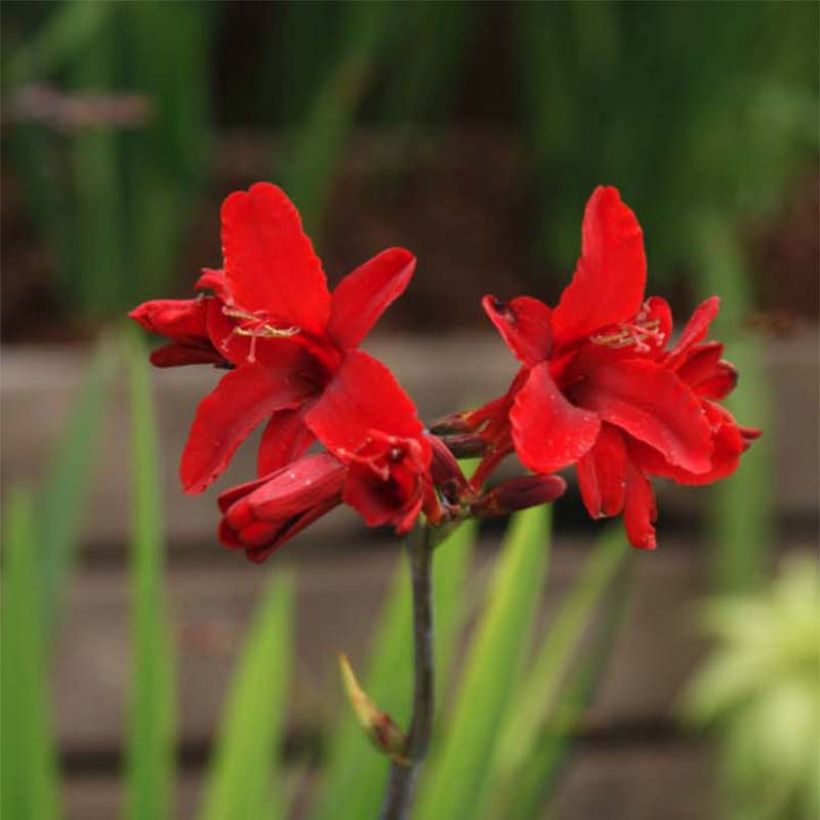

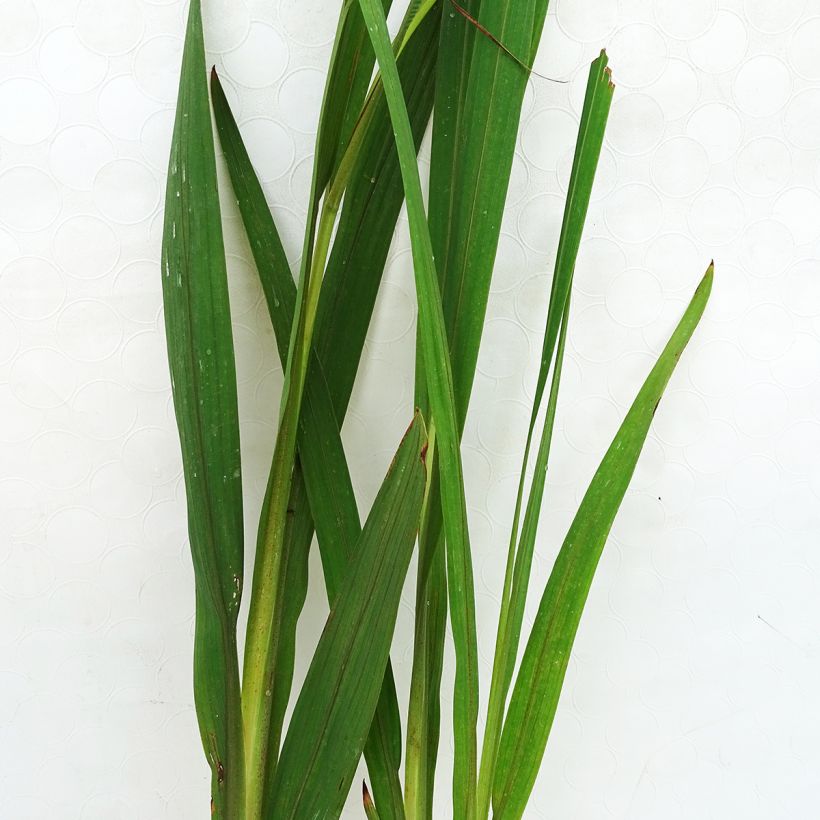

Flowering
Foliage
Plant habit
Botanical data
Crocosmia
Hellfire
Iridaceae
Montbretia
Cultivar or hybrid
Other Crocosmia
Planting and care
Plant crocosmias in full sun, preferably in spring. They need a well-drained and airy soil. Prepare the soil well at the time of planting, and if necessary, incorporate some sand. They should be covered with 5 to 8 cm (2 to 3in) of soil and spaced about fifteen cm apart. They like rich soils. Apply fertiliser at the time of planting, which should be reapplied every spring. While they prefer well-drained soil during winter, crocosmias need plenty of water during their growing period and cannot tolerate any drought in summer. In regions with harsh winters, digging up the corms once the foliage has withered and storing them in a frost-free location is advisable. Another alternative is to cover the bed with horticultural fleece in early winter and remove it in March.
Planting period
Intended location
Care
-
, onOrder confirmed
Reply from on Promesse de fleurs
Haven't found what you were looking for?
Hardiness is the lowest winter temperature a plant can endure without suffering serious damage or even dying. However, hardiness is affected by location (a sheltered area, such as a patio), protection (winter cover) and soil type (hardiness is improved by well-drained soil).

Photo Sharing Terms & Conditions
In order to encourage gardeners to interact and share their experiences, Promesse de fleurs offers various media enabling content to be uploaded onto its Site - in particular via the ‘Photo sharing’ module.
The User agrees to refrain from:
- Posting any content that is illegal, prejudicial, insulting, racist, inciteful to hatred, revisionist, contrary to public decency, that infringes on privacy or on the privacy rights of third parties, in particular the publicity rights of persons and goods, intellectual property rights, or the right to privacy.
- Submitting content on behalf of a third party;
- Impersonate the identity of a third party and/or publish any personal information about a third party;
In general, the User undertakes to refrain from any unethical behaviour.
All Content (in particular text, comments, files, images, photos, videos, creative works, etc.), which may be subject to property or intellectual property rights, image or other private rights, shall remain the property of the User, subject to the limited rights granted by the terms of the licence granted by Promesse de fleurs as stated below. Users are at liberty to publish or not to publish such Content on the Site, notably via the ‘Photo Sharing’ facility, and accept that this Content shall be made public and freely accessible, notably on the Internet.
Users further acknowledge, undertake to have ,and guarantee that they hold all necessary rights and permissions to publish such material on the Site, in particular with regard to the legislation in force pertaining to any privacy, property, intellectual property, image, or contractual rights, or rights of any other nature. By publishing such Content on the Site, Users acknowledge accepting full liability as publishers of the Content within the meaning of the law, and grant Promesse de fleurs, free of charge, an inclusive, worldwide licence for the said Content for the entire duration of its publication, including all reproduction, representation, up/downloading, displaying, performing, transmission, and storage rights.
Users also grant permission for their name to be linked to the Content and accept that this link may not always be made available.
By engaging in posting material, Users consent to their Content becoming automatically accessible on the Internet, in particular on other sites and/or blogs and/or web pages of the Promesse de fleurs site, including in particular social pages and the Promesse de fleurs catalogue.
Users may secure the removal of entrusted content free of charge by issuing a simple request via our contact form.
The flowering period indicated on our website applies to countries and regions located in USDA zone 8 (France, the United Kingdom, Ireland, the Netherlands, etc.)
It will vary according to where you live:
- In zones 9 to 10 (Italy, Spain, Greece, etc.), flowering will occur about 2 to 4 weeks earlier.
- In zones 6 to 7 (Germany, Poland, Slovenia, and lower mountainous regions), flowering will be delayed by 2 to 3 weeks.
- In zone 5 (Central Europe, Scandinavia), blooming will be delayed by 3 to 5 weeks.
In temperate climates, pruning of spring-flowering shrubs (forsythia, spireas, etc.) should be done just after flowering.
Pruning of summer-flowering shrubs (Indian Lilac, Perovskia, etc.) can be done in winter or spring.
In cold regions as well as with frost-sensitive plants, avoid pruning too early when severe frosts may still occur.
The planting period indicated on our website applies to countries and regions located in USDA zone 8 (France, United Kingdom, Ireland, Netherlands).
It will vary according to where you live:
- In Mediterranean zones (Marseille, Madrid, Milan, etc.), autumn and winter are the best planting periods.
- In continental zones (Strasbourg, Munich, Vienna, etc.), delay planting by 2 to 3 weeks in spring and bring it forward by 2 to 4 weeks in autumn.
- In mountainous regions (the Alps, Pyrenees, Carpathians, etc.), it is best to plant in late spring (May-June) or late summer (August-September).
The harvesting period indicated on our website applies to countries and regions in USDA zone 8 (France, England, Ireland, the Netherlands).
In colder areas (Scandinavia, Poland, Austria...) fruit and vegetable harvests are likely to be delayed by 3-4 weeks.
In warmer areas (Italy, Spain, Greece, etc.), harvesting will probably take place earlier, depending on weather conditions.
The sowing periods indicated on our website apply to countries and regions within USDA Zone 8 (France, UK, Ireland, Netherlands).
In colder areas (Scandinavia, Poland, Austria...), delay any outdoor sowing by 3-4 weeks, or sow under glass.
In warmer climes (Italy, Spain, Greece, etc.), bring outdoor sowing forward by a few weeks.

































